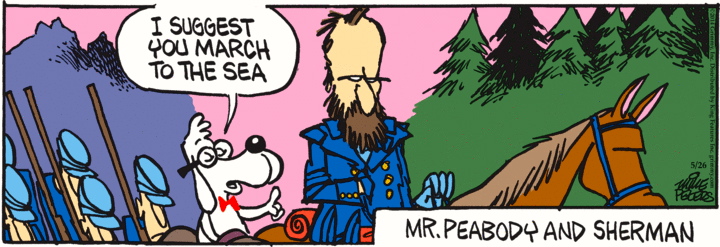For (U.S.) Memorial Day — today — three diverse cartoons, none of them about war or memorializing troops: A PHD Comics on ambiguity; a Doonesbury on vegetable (parallel to animal) language; and a Mother Goose and Grimm uniting two Shermans (so there’s a bit about war in there — the (U.S.) Civil War).
1. Piled High and Deeper on done. A link from Johan Rooryck to Jorge Cham’s PHD Comics of the 23rd:
Doing research. But now the grad student and the professor are done.
2.The language of plants. Meanwhile, on Doonesbury this morning, Zonker Harris coaxes his plants to recite:
Vegetable language (I suppose), similar to animal language — but like much research on animal communication it has to do not with living things communicating according to their own schemes, but with them using (some version of) human communication systems.
As in many studies of animal communication, the experimental subjects aren’t always plugged into the program and fully cooperative. But note that the question in the last panel comes from a plant (one that is certainly not a geranium).
Hey, if slime molds, why not geraniums?
3. Sherman in Mother Goose and Grimm. Also from this morning. A tribute to how much background knowledge you might need to understand a cartoon.
A kind of topical portmanteau, combining the cartoon characters Mr. Peabody and Sherman with General William Tecumseh Sherman’s “march to the sea” in the Civil War. The shared element is the name Sherman.
Mr. Peabody first. From Wikipedia:
Mr. Peabody is a cartoon dog who appeared in the late 1950s and early 1960s television animated series Rocky and His Friends and The Bullwinkle Show, produced by Jay Ward. Peabody appeared in the Peabody’s Improbable History segments created by Ted Key, and was voiced by Bill Scott, while Sherman was voiced by Walter Tetley.
The cartoons are about Peabody, a beagle who is the smartest being in existence. Peabody has accomplished many things in his life as a business magnate, inventor, scientist, Nobel laureate, gourmand, and two-time Olympic medalist. One day, Mr. Peabody becomes sad and lonely and decides to adopt his own human son. In an alley, he meets Sherman, a dorky, glasses-wearing, orange-haired boy. After saving Sherman from a group of bullies, Peabody discovers that Sherman is an orphan and decides to adopt him.
Peabody realizes that boys need running room and so invents the WABAC machine [WABAC ‘way back’, now adapted as the Wayback Machine in computer systems] as a birthday gift for Sherman. He and Sherman then go back in time to see a Roman speaking in Latin; Peabody then adds a translator circuit to the machine so that everyone seems to speak English and see the Roman again finding out he is a used chariot salesman.
… Peabody makes … adjustments, turning the WABAC from a time machine into a “should-have-been machine.” This results in the past they visit being totally cockeyed (including anachronisms and famous people behaving totally out of character).
Wonderfully quirky. General Sherman is sterner stuff. Again from Wikipedia:
William Tecumseh Sherman (February 8, 1820 – February 14, 1891) was an American soldier, businessman, educator and author. He served as a General in the Union Army during the American Civil War (1861–65), for which he received recognition for his outstanding command of military strategy as well as criticism for the harshness of the “scorched earth” policies that he implemented in conducting total war against the Confederate States.
… In 1864, Sherman succeeded [Ulysses S.] Grant as the Union commander in the western theater of the war. He proceeded to lead his troops to the capture of the city of Atlanta, a military success that contributed to the re-election of President Abraham Lincoln. Sherman’s subsequent march through Georgia and the Carolinas [the “march to the sea”] further undermined the Confederacy’s ability to continue fighting.
So the cartoon depicts Mister Peabody and General Sherman.



